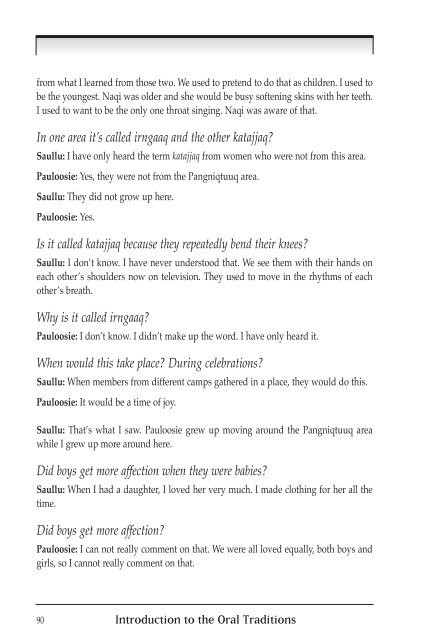Introduction-E
Introduction-E
Introduction-E
Create successful ePaper yourself
Turn your PDF publications into a flip-book with our unique Google optimized e-Paper software.
from what I learned from those two. We used to pretend to do that as children. I used to<br />
be the youngest. Naqi was older and she would be busy softening skins with her teeth.<br />
I used to want to be the only one throat singing. Naqi was aware of that.<br />
In one area it’s called irngaaq and the other katajjaq?<br />
Saullu: I have only heard the term katajjaq from women who were not from this area.<br />
Pauloosie: Yes, they were not from the Pangniqtuuq area.<br />
Saullu: They did not grow up here.<br />
Pauloosie: Yes.<br />
Is it called katajjaq because they repeatedly bend their knees?<br />
Saullu: I don’t know. I have never understood that. We see them with their hands on<br />
each other’s shoulders now on television. They used to move in the rhythms of each<br />
other’s breath.<br />
Why is it called irngaaq?<br />
Pauloosie: I don’t know. I didn’t make up the word. I have only heard it.<br />
When would this take place? During celebrations?<br />
Saullu: When members from different camps gathered in a place, they would do this.<br />
Pauloosie: It would be a time of joy.<br />
Saullu: That’s what I saw. Pauloosie grew up moving around the Pangniqtuuq area<br />
while I grew up more around here.<br />
Did boys get more affection when they were babies?<br />
Saullu: When I had a daughter, I loved her very much. I made clothing for her all the<br />
time.<br />
Did boys get more affection?<br />
Pauloosie: I can not really comment on that. We were all loved equally, both boys and<br />
girls, so I cannot really comment on that.<br />
90 <strong>Introduction</strong> to the Oral Traditions


